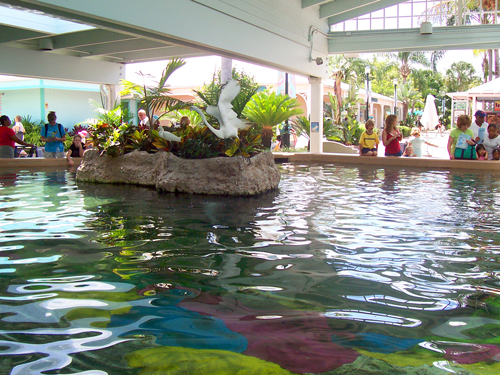Rose Pacifico
Rpacifi@schools.nyc.gov
PS 306, 40 West Tremont Avenue, Bronx, NY 10453
Grade/Subject: 3-5th- Science
| About the Grant: |

Students wil learn the correct procedures for hydroponics gardening in the classroom. They will be able to accomplish this by investigating a variety of media and
by learning the characteristics of organisms and life cycles. The teacher will begin this unit of study by incvolving the students in short hands-on activities . These
activities will involve exploring some key factors affecting hydroponic setups. They will be able to decide what materials they could use for their hydroponics
garden. Students will then design their floating styrofoam raft.
The materials needed for this unit are water, ph paper, or test kit, vinegar, baking soda , containers, distilled water, measuring equipment, stirring rods, nutrients,
graduated cylinders, aerators, pumps, students journals and pencils. They will also need planst seeds or small plant shoots with roots. |
|
|
| How This Grant was Adapted: |
Teachers can encourage students in this unit by asking questions about objects, organisms, and events. They can also plan and conduct investigations
and encourage students to seek information from reliable sources. Teachers can engage the students through the hands-on activities to explore "stations" that could
be set up as learning centers before or during hydroponics study. |
|
|
| Project URL |
|
|
|
| Objectives |
Learning Objectives
- Learning correct procedures for combining materials.
- Investigating different kinds of media.
- Learning the characteristics of organisms and life cycles.
- Asking questions about objects, organisms, and events.
- Planning and conducting investigations.
- Seeking information from reliable sources.
- Learning to work in teams to collect data and share information and ideas.
|
|
|
| Websites Used |
This site allows students to learn the basics of hydroponics and also provides definitions and other resources for hydroponics setups. http://growingedge.com/kids/growing_info.htm
The National Gardening Association (NGA), founded in 1973, is a nonprofit leader in plant-based education. We serve a national audience. We use gardening as a vehicle
for encouraging children to make good food choices, augmenting classroom studies with experiential learning, building a love of nature, stimulating social interaction,
facilitating cultural exchange, and more. http://garden.org/, http://kidsgardening.com/
- Bradley Hydroponics
Learn all about hydroponic projects going on around the world, hydroponic games, nutrition, and much more.
- Carbon Quest
Projects from all over the world--including hydroponics--are illustrated at this great Web site.
- Hydroponic University
Beginning students of hydroponics will find some great resources at this site, including tips, a forum for asking questions, and free system plans.
- National Gardening Association
This great site is dedicated to helping kids get involved in gardening.
|
|
|
| Standards Addressed: |
Please list the New York State standards which apply to your unit. Indicate grade and subject area for each standard. Please copy the text of each standard;
do not list them by number.
- Standard MST4:Science Students will understand and apply scientific comcepts, principles, and theories pertaining to the physical setting and living environment
and recognize the historical development of ideas in science.
- Key Idea Introduction: All organisms must be able to obtain and use resources, grow, reproduce and maintain stable internal conditions while living in
a constantly changing external environment. Organisms respond to internal or environmental stimuli.
- Standard MST5: Technology: Students will apply technological knowledge and skills to design, conduct, use, and evaluate products and systems to satisfy human
and environmental needs.
- Key Idea MST5.ED1: Engineering desing is an itirative process involving modeling and optimmizations used to develop technological solutions to problems
within given constraints.
|
|
|
| Lesson 1: |
Title: The basics of hydroponics
Objectives: To explore the basics of hydroponics through hands-on activities
Materials:
- water,
- containers,
- measuring equipment,
- nutrients,
- seeds or small plants,
- aerators,
- pumps,
- students journals and
- pencils.
Procedures: Students will follow directions to explore the basics of hydroponics.
They will work together in groups of two to complete the activites and answer the challenging questions for each station.
Assessment: Student swill design the hydroponics planter in their journals and label the parts.
Homework: Studens will design other hydroponics planters. |
|
|
| Lesson 2: |
Title: Key Factors of Hydroponics setups
Objectives: Students will use the laptops to explore key factors of hydroponics setups.
Materials:
- Laptops,
- Printer,
- internet access,
- students journals,
- pencils
Procedures: Students will access the internet on their laptops and take notes in their student journals to learn the key factors of hydroponics setups.
Assessment: Students will be required to label a worksheet about hydroponics setups. GRAPHING RUBRIC.doc
Homework: Students will constinue to research hydroponics setups at home. |
|
|
| Lesson 3: |
Title: Materials that can be used for Hydroponics setups
Objetives: Students will be able to decide what materials they could use for their hydroponics Styrofoam container
Materials:
- laptops,
- printer,
- jump drive,
- smart board,
- internet access,
- chart paper,
- student journals,
- pencils
- Hydroponics Diagram
Procedures: Students will create their design for their floating styrofoam raft using all the information they have gathered.
Assessment: Students will be required to explain how each part of the styofoam raft will work to allow pants to grow.
Homework: Students will write about their styrofoam raft in their student journals. |
|
|
| Lesson 4 |
Title: Hydroponics and plant growth
Objective: Students will learn that plants need food, air, and light and water purification in order to grow.
Materials:
- Laptops,
- internet access,
- smart board,
- chart paper,
- student journals,
- pencils.
Procedures: Students will research how plants will grow in the styrofoam raft.
Assessment: Students will describe how each part of the styrofoam raft will provide food, air, light and water purification to allow plants to grow.
Homework: Students will write (1 Paragaph) in their student journals about their styrofoam raft. |
|
|
|

Rose Pacifico has taught in both private and public schools for over 20 years. She is currently teaching 4th grade in PS 306. Mrs. Pacifico has a masters degree
in Literacy form the University of Albany and a degree in administration.
Hydroponics Diagram
|